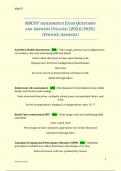NBCOT
NBCOT ASSESSMENTS EXAM QUESTIONS
AND ANSWERS UPDATED (2024/2025)
(VERIFIED ANSWERS)
Activities Health Assessment - ANS ✓Time usage, patterns and configurations
of activities, roles and underlying skills and habits
Color-coded chart past on time spent during week
Idiosyncratic Activities Configuration Questionnaire
Interview
No score, based on interpretation of balance in life
Adults through elders
Adolescent role assessment - ANS ✓Development of internalized roles within
family, school and social settings
Semi-structured interview, on family, school, peers, occupational choice, and
work
Scored as appropriate, marginal, or inappropriate, ages 13-17
Barth Time construction BTC - ANS ✓Time usage, roles and underlying skills
and habits
Color-coded chart
Percentages of time calculated, appropriate use of time discussed
Adolescent through elder
Canadian Occupational Performance Measure COPM - ANS ✓Identifies
perception of satisfaction with performance and changes over time
Semi-structured, self-care, productivity, leisure
1
NBCOT Assessments
,NBCOT
Individuals over age of 7 or parents of small children
Occupational circumstances assessment interview rating scale OCAIRS -
ANS ✓Nature and extent of individual's occupational adaptation
Obtains, analyzes and reports info relevant to intervention and discharge
12 areas of adaptation-personal causation, self-perception, social, physical,
values, interests, roles habits skills, goals
semi-structured interview, rate 1-4, interpret data according to moho
designed for adults through elders with psych diagnoses, now used broader
Occupational Performance history Interview OPHI
Life history, past and present performance, impact - ANS ✓Life history, past
and present performance, impact of disability
Sem-structured interviewed, 5 areas addressing daily routines
Rates identity and competence on scale of 104
Adolescents to elders
Role checklist - ANS ✓Self-reported role participatation
Part one-major roles in past, part 2-degree values each role
Adolescents through elders with physical or psycho dysfunction
SCI
ASIA Impairment - ANS ✓A-complete, no sensory or motor
B-incomplete, sensory but no motor
C-incomplete-motor preserved below neurological level, key muscles have grade
3/5
D-incomplete-motor function, greater than 3/5 grade
E-normal
Hoehn and Yahr's five stage scale - ANS ✓Parkinson's
2
NBCOT Assessments
, NBCOT
I-unilateral tremor, rigidity, minimal or no functional impairment
II-bilateral tremor, rigidity, with or without axial signs, independent with ADL, no
balance impairment
III-impaired righting reflex, onset of disability
IV-requires help, able to walk and stand unaided
V-confined to wheelchair or bed, max A
Sensory integration and praxis tests (SIPT) - ANS ✓Standardized, ages 4-8
17 tests address tactile processing, vestibular proprioceptive, visual perception
and practice ability
categorized into : tactile and vestibular-proprioceptive sensory processing, form
and space perception and visual motor coordination, practice ability, and
measures of bilateral integration and sequencing
DeGangi-Berk Test of Sensory Integration (TSI) - ANS ✓Standardized, ages 3-
5, measures sensory integrative function, focus on vestibular
Three areas: bilateral motor coordination, postural control, and reflex integration
Test of sensory functions in infants - ANS ✓Standardized, 1-18 months
Level of infant's sensory responsiveness to variety of stimuli
Sensory processing measure (SPM) - ANS ✓Elementary, sensory processing,
praxis, social participation
Visual, auditory, tactile, olfactory-gustatory, proprioceptive, and vestibular
Home form-primary caregiver, main classroom from-teacher, school
environments form-other personnel
Assessment of Motor and Process Skills (AMPS) - ANS ✓3 and older
functional competence in two or three familiar BADL or IADL
choose activities from a list of 80
3
NBCOT Assessments




